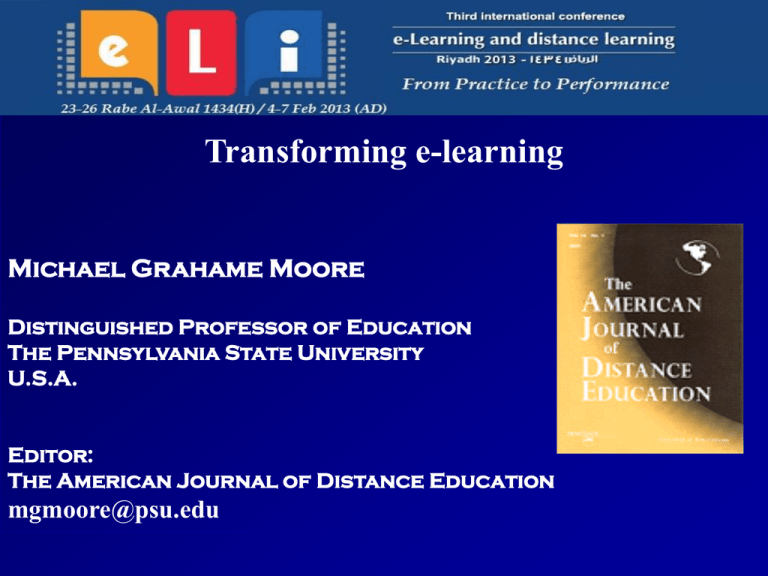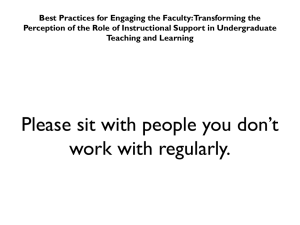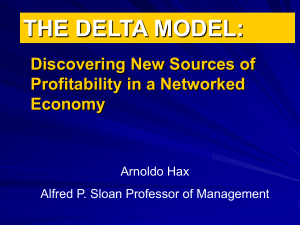Slide 1
advertisement

Transforming e-learning Michael Grahame Moore Distinguished Professor of Education The Pennsylvania State University U.S.A. Editor: The American Journal of Distance Education mgmoore@psu.edu “To transform e-learning into engaging performance-driven learning experiences” Key words: “transforming” : how can e-learning be improved? “engaging” : how to transform the experience of students and the environments in which they learn ? “performance driven”: how to transform teaching so it is more effective and “engaging” ? Transforming learning and teaching requires transformations in educational institutions Transforming institutions requires transformation in policies governing the allocation of resources Transforming e-learning: the context information age knowledge based society post-modern society driven by digital technologies http://www.internetworldstats.com/stats5.htm#me http://www.internetworldstats.com/stats5.htm#me “engaging technologies” Interactive social user or locally generated open access user managed “engaging” technologies E-learning to M-Learning in the cloud 2010: 7.5 billion devices 2015: 15.0 billion devices 80% Internet by mobiles (Cisco) engaging technologies: gaming Engaging technologies Learning Analytics and Adaptive learning analysis of each student’s prior experience, performance, strengths and weaknesses, point to prescribed content tailored to that student. data about prior learning captured from learning management system including time spent on a resource, frequency of posting, and number of logins. Heavy investment by for-profit test preparation companies Grockit and Knewton Engaging technologies: summary Old technology Analog Generic Information delivery Expert driven Uni-directional Closed Static Predictable Limited availability New technology Digital Personal Information exchange User driven Networked Open Mobile Adaptable Widespread How is e-learning to be transformed? Transforming views of learning and learners Transforming roles of teachers Transforming role of course designers Transforming institutions Transforming views of learning (1) “Engaged” learning is (a) personal and also (b) social (a) Personal: engaged learners generate knowledge from within, not by absorbing information from outside engaged learners make meaning out of their own experiences engaged learning requires reflection and meta-cognition immediate outcomes of a engaged learning experiences are varied and often unpredictable 12 Transforming views of learning (2) (b) Engaged learning is social: -- values knowledge distributed across a community --- values shared inquiry -- values learning based on experience (real or simulated) -- values non-linear as well as traditional forms of expression -- encourages co-design of experiences An engaged learning community: -- has diversity of expertise among its members -- expects and values contributions from all --- has mechanisms for sharing what is learned -- common objective to advance collective knowledge -- shared emphasis on learning how to learn Transforming views of learners engaged learners need new skills: searching, sorting, sifting and evaluating multi-tasking synthesizing communicating reflecting immersion Transforming the role of teacher From performer to conductor – of engaging learning environments ! facilitating students’ searching – individually and collaboratively linking and weaving ideas and information created by students, summarizing, pulling together the threads, managing and sifting information relating the particular experience to general theory monitor each student’s performance against expected standards and intervene when needed Transforming the role of the teacher: FOCUS ON PERFORMANCE Engaging learning – personal, social, open, flexible, interactive -increased risk of student (and also instructors) becoming lost Therefore success depends on clarity and agreement about expected results -- observable and measurable -- in student performance did each student’s performance indicate having learned what was required and if not, why not? Observable performance requires a product – an assignment Focus on assignment is motivating for student and instructor Interaction is only a means towards performance objective Importance of continuous monitoring (formative evaluation) Data reported from monitoring provides feedback for improvement of system and for instructor training Transforming e-learning : the institutional challenge The structure of universities has not changed to keep pace with e-learning technology The classroom is not the appropriate model for e-learning. It is no longer viable for an individual to be equally expert in subject matter, technology management, course design, evaluation, facilitating group interaction and individualization of learning It is no longer viable for an institution to be equally expert and competitive in every subject-matter, relevant technology, course design, evaluation and teaching Transforming e-learning requires specialization of individuals and institutions, with each focused on its comparative advantage and extending to a potential national or global population This means re-organizing resources in and between institutions Traditional Policy Faculty and staff establishments are: based on permanent positions, vertical divisions and hierarchical relationships Funds are allocated: for line items in a budget fixed for specified periods, usually 12 months Transforming Policy Faculty and staff establishments will : provide teams that cut across vertical divisions for specific projects and allow for redeployment to reflect changing needs Funds will be allocated: for the heavy front-end investment in designing technology based learning for amortisation of costs over the lifetimes of programs -- usually more than 12 months (based on RSA Telematics initiative) Transforming organizational systems Strategic alliances Virtual systems Independent study – MOOCS and badges Strategic Alliances in USA states EXAMPLES Connecticut Distance Learning Consortium One MBA American Distance Education Consortium Hispanic Educational Technology Services What is Semester Online? “ Semester Online is a consortium of top colleges and universities. It is the first program of its kind to offer undergraduate students the opportunity to take rigorous, online courses for credit from some of the country’s leading universities. Semester Online is a for-credit, online program for undergraduates offering rigorous courses, where students will have access to renowned professors from multiple, highly selective institutions. Courses are taught live, in small groups where students are surrounded by outstanding peers and guided by renowned professors – much as they would be if they were on campus. Compelling, richly produced, self-paced course materials are designed with university faculty and are accessible 24 hours a day. Familiar social networking tools allow students to connect and build relationships with peers from their school and other schools online.” The AVU collaborating partners include: •African Ministries of Education •African Union •Association of African Universities •UNESCO IIEP •UNESCO BREDA •UNESCO Teacher Training Program in Sub-Saharan Africa •Association of Universities and Colleges of Canada •Open University of UK- TESSA •Universite� Laval Canada •University of Ottawa Canada •Memorial University of Newfoundland •Curtin University Australia •Indiana University in Pennsylvania, USA •Maestro, Washington DC, USA •International Development and Research Centre, Canada •Partnership for Higher Education in Africa •MIT Open Courseware •Merlot African Network •South African Institute for Distance Learning •Commonwealth of Learning •Global Text Project Strategic Alliances: African Virtual University A new model: virtual systems A system that designs and delivers learning programs by commissioning the component processes and services from all available agencies. The general principle is that a state or nation - can draw on the best resources wherever they are located to build a network of — content experts, instructional designers, communications technologies, group facilitators and a learner support system — and configure whatever mixture is needed for a particular program or project on a flexible, open, "mix and match" basis. An example of virtual system: PROFORMACAO Brazil’s teacher education program The Brazil problem 72,522 rural primary schoolteachers needing training Solution: o National coordinating group to recruit and manage teams of specialists in subjects, instructional design, pedagogy, technologies o To design courses for delivery at home and school o Supported by local tutors o Trained by state-level teacher-educators o With performance measured by regular assignments o Monitored at state and central levels o with training interventions when needed at state/local or national levels Virtual system Brazil Funder Management team National advisory ctee Course design teams UNIVERSITY 1 UNIVERSITY 2 UNIVERSITY 3 S T U D E N T S Production & distribution team Platform video company 1, 2 Publisher 1,2, Software 1,2 tutors tutors tutors tutors State coordinators Study center Study center State monitoring and training teams Study center Study center Municipal teacher 1 Municipal teacher 2 Etc State UNIVERSITY 1 State UNIVERSITY 2 State UNIVERSITY 3 Conditions for success Technology: advanced at central and regional levels, simple at village level Design: Strictly performance centered world class content, software, instructional design specialists Delivery system: integrated design, learner support, training and tutorial system with weekly performance monitoring and data reporting Financial : large investment with low average costs due to economies of scale Political : national leadership, state and local agreements A New, Demand-Driven Model of E-learning : Independent Learning “consumer,” (the learner), not the “supplier” – university, or other provider decides what is to be learned, when, where, how, or to what extent. Faculty not limited to any one place (or virtual institution) Students learn wherever they are located from teachers and instructional resources wherever they are located from any institution or country at any time and in any combination Recent manifestation: MOOCS (Massive online open Courses), free e-learning offered by major institutions, not part of a degree or other structure. Learners can mix with other experiences into a personal portfolio of achievement (performance). Examples: Stanford University -- 160,000 students in 190 countries in a course on Artificial Intelligence Massachusetts Institute of Technology : course materials online accessed by 100 million people in 2,000 courses Udemy: private for-profit site for experts to teach and anyone to learn. Breaking the institutional monopoly of certification. educational institutions have monopoly over the supply of teaching by controlling certification – that monopoly is under threat from “badge” movement. Mozilla Open Badge Infrastructure (OBI) A badge is a certification of what a student knows Open Badges Infrastructure will let students gather such badges from any site on the internet, combining them into a porfolio regardless of where they learned. The Mozilla Foundation with funding support from the MacArthur Foundation to develop the Open Badges Infrastructure, aiming to provide the basic building blocks for any organization to offer badges in a standard, interoperable manner. Mozilla is currently developing its own badges for things like Javas cript course, but other groups are contemplating developing digital badges including NASA and the US Department of Education. https://wiki.mozilla.org/Badges/infrastructure-tech-docs Performance in the news. Wisconsin’s Governor Walker: "We’re going to tie our funding in our technical colleges and our University of Wisconsin System into performance and say if you want money, we need you to perform, and particularly in higher education, we need you to perform not just in how many people you have in the classroom that means not only degrees, but are young people getting degrees in jobs that are open and needed today, not just the jobs that the universities want to give us, or degrees that people want to give us?" Source: http://host.madison.com/ Concluding questions How much is engaging learning and performance centered teaching implemented in your institution ? What transformations are needed? What is your opinion of John Dewey’s 1916 prediction? ‘A society which is mobile, which is full of channels for the distribution of a change occurring anywhere, must see to it that its members are educated to personal initiative and adaptability. Otherwise, they will be overwhelmed by the changes in which they are caught and whose significance or connections they do not perceive.’ Thank you for your attention Comments? Questions? mgmoore@psu.edu www.routledge.com/u/HBofDistanceEdu3e Available November 2012 | 640 pages | Paperback: 978-0-415-89770-9



